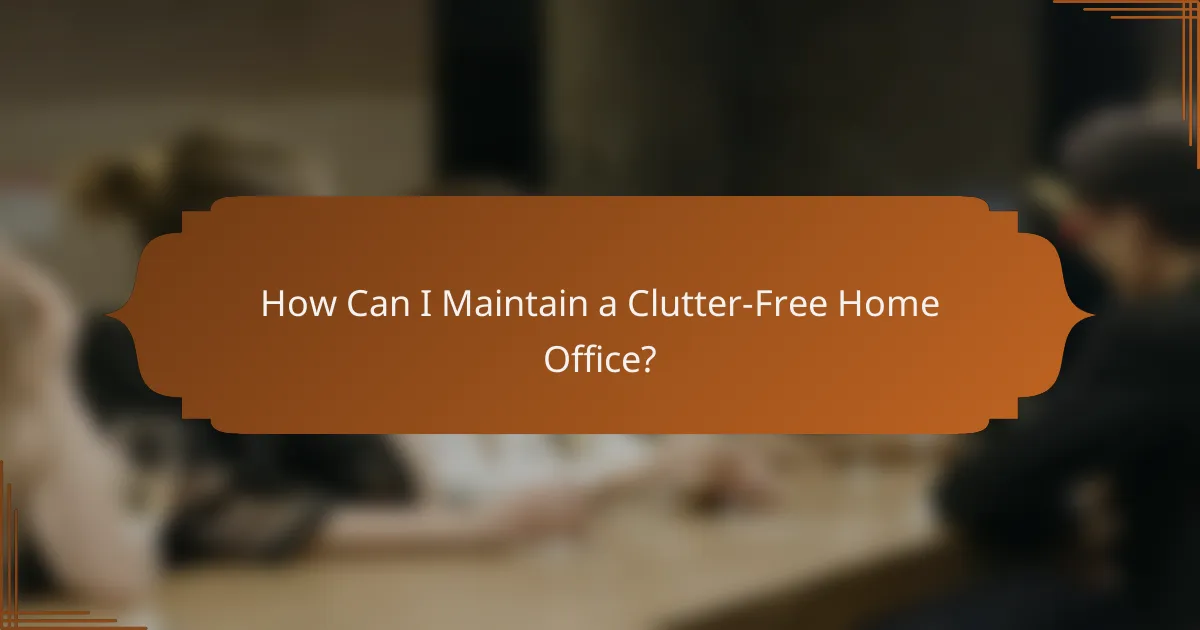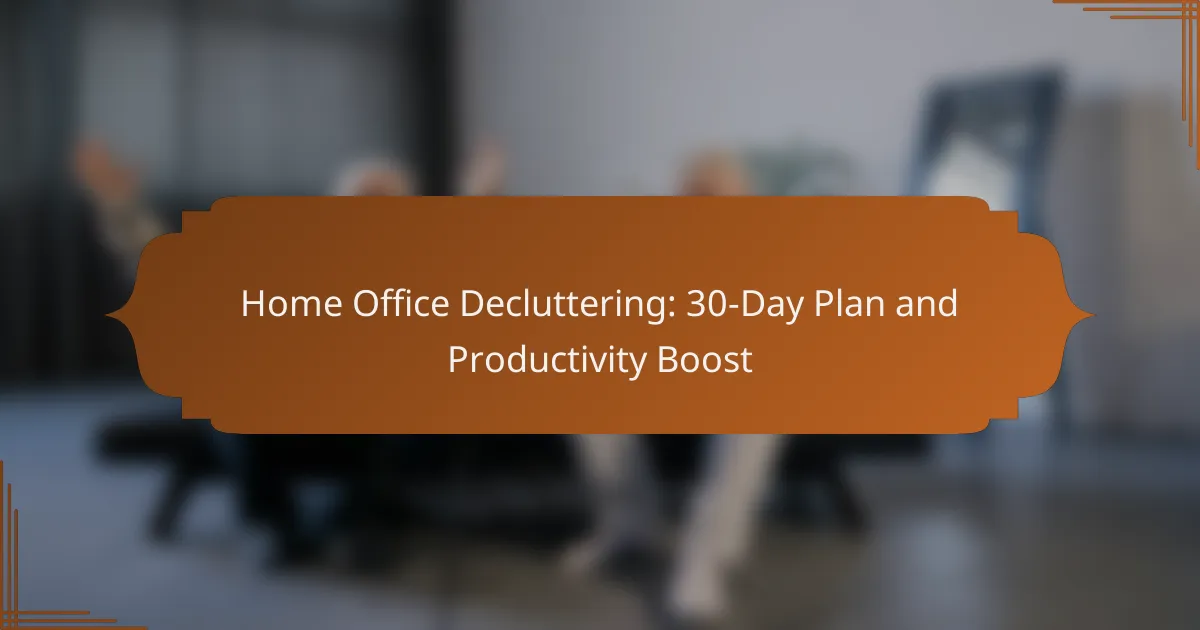Transforming your home office into a clutter-free zone can significantly enhance your productivity and focus. By following a structured 30-day decluttering plan, you can systematically tackle the most cluttered areas and create a more organized workspace. Consistent cleaning routines and regular evaluations of your items will help maintain this newfound order, ensuring your office remains a space conducive to work and creativity.

How Can I Start Decluttering My Home Office?
To start decluttering your home office, focus on identifying the most cluttered areas and set a clear plan to tackle them. A structured approach will help you create a more organized and productive workspace.
Identify key areas to declutter
Begin by pinpointing the areas in your home office that need the most attention. Common spots include your desk, filing cabinets, shelves, and digital files. Take a moment to assess which areas feel overwhelming or disorganized.
Consider creating a checklist of these key areas to ensure you address each one. Prioritize them based on how cluttered they are and how much they impact your productivity.
Set a decluttering schedule
Establish a realistic decluttering schedule that fits your daily routine. Aim to dedicate a specific time each day or week to focus on one area at a time. This could be as little as 15-30 minutes daily or a couple of hours on weekends.
Consistency is key; try to stick to your schedule to maintain momentum. You might find it helpful to mark your progress on a calendar or planner.
Gather necessary supplies
Before you start decluttering, gather essential supplies to make the process smoother. You may need boxes or bins for sorting items, trash bags for unwanted items, and labels for organizing. Having everything on hand will minimize distractions.
Consider using a shredder for sensitive documents and a recycling bin for paper waste. This will help you efficiently dispose of items that no longer serve a purpose.
Establish a sorting system
Develop a sorting system to categorize items as you declutter. Common categories include keep, donate, recycle, and trash. This will streamline the decision-making process and help you stay focused.
Label each box or bin clearly to avoid confusion. You might also want to set a limit on how many items you keep, encouraging you to make thoughtful choices about what truly matters.
Utilize storage solutions
After sorting, implement effective storage solutions to keep your home office organized. Use shelves, drawer organizers, and filing systems to maximize space. Vertical storage can be particularly useful for small areas.
Consider investing in clear containers for visibility and easy access. Labeling shelves and bins will also help maintain organization and make it easier to find items when needed.

What Are Effective Decluttering Strategies?
Effective decluttering strategies help you streamline your home office, enhancing both organization and productivity. By employing structured methods, you can reduce clutter systematically, making it easier to maintain a tidy workspace.
Use the Marie Kondo method
The Marie Kondo method focuses on keeping items that “spark joy.” Begin by gathering all items in a category, such as books or office supplies, and evaluate each one based on its emotional impact.
To implement this method, set aside time for each category and be decisive. If an item does not bring joy or serve a clear purpose, consider donating or discarding it. This approach not only clears physical space but also promotes a positive mindset.
Implement the 4-Box method
The 4-Box method involves using four boxes labeled: Keep, Donate, Trash, and Relocate. As you declutter, place each item into one of these boxes to make decisions straightforward.
This strategy encourages you to think critically about each item’s value and helps prevent indecision. Regularly review the contents of each box to ensure you follow through with your decluttering goals.
Apply the one-in-one-out rule
The one-in-one-out rule states that for every new item you bring into your home office, one must leave. This principle helps maintain balance and prevents clutter from accumulating.
To effectively apply this rule, keep a list of items you plan to remove whenever you acquire something new. This practice fosters mindfulness about your purchases and encourages a more intentional approach to your workspace.

How Can I Maintain a Clutter-Free Home Office?
To maintain a clutter-free home office, establish consistent cleaning routines and regularly evaluate the items you keep. This proactive approach not only keeps your workspace tidy but also enhances productivity and focus.
Create daily cleaning habits
Developing daily cleaning habits is essential for sustaining a clutter-free environment. Set aside a few minutes at the end of each workday to tidy up your desk, file away documents, and discard unnecessary items. This small commitment can prevent clutter from accumulating over time.
Consider creating a checklist of daily tasks, such as organizing your workspace, wiping down surfaces, and ensuring all materials are in their designated places. This routine can help reinforce the habit and make it easier to maintain cleanliness.
Regularly reassess office items
Regularly reassessing the items in your home office is crucial for maintaining organization. Schedule time every month to evaluate what you truly need and what can be discarded or donated. This practice helps prevent the buildup of unnecessary items that can distract you.
When reassessing, ask yourself if each item serves a purpose or brings you joy. If it doesn’t, consider letting it go. You can also implement a one-in-one-out rule: for every new item you bring in, remove an old one to keep your space manageable.
Utilize digital organization tools
Digital organization tools can significantly enhance your ability to maintain a clutter-free home office. Utilize applications for task management, note-taking, and document storage to reduce physical paperwork. Tools like Trello, Evernote, or Google Drive can help streamline your workflow and keep your digital space organized.
Additionally, consider setting up a digital filing system with clearly labeled folders to easily locate important documents. Regularly back up your files and declutter your digital workspace to ensure efficiency and reduce distractions.

What Are the Benefits of a Decluttered Home Office?
A decluttered home office offers numerous advantages, including improved productivity, enhanced focus, and reduced stress. By organizing your workspace, you create an environment that fosters efficiency and creativity.
Increased productivity
Decluttering your home office can significantly boost your productivity. A tidy workspace minimizes distractions, allowing you to concentrate better on tasks. Studies suggest that individuals in organized environments often complete tasks more quickly and efficiently.
To maximize productivity, consider implementing a system for organizing your materials. Use labeled storage boxes or digital tools to keep track of important documents. Regularly reassess your workspace to eliminate items that no longer serve a purpose.
Enhanced focus and creativity
A clean and organized home office enhances your ability to focus and sparks creativity. When your environment is clutter-free, your mind can think more clearly, leading to innovative ideas and solutions. Creative tasks often require mental clarity, which can be hindered by disorganization.
To foster creativity, create designated areas for different types of work. For example, have a specific spot for brainstorming and another for administrative tasks. This separation can help your brain switch gears more effectively.
Reduced stress levels
Clutter can contribute to feelings of stress and overwhelm. By decluttering your home office, you create a more peaceful atmosphere, which can lead to lower anxiety levels. A serene workspace promotes a sense of control and well-being.
To keep stress at bay, establish a routine for maintaining your office’s organization. Set aside a few minutes each day to tidy up and ensure everything is in its place. Consider incorporating calming elements, such as plants or soothing colors, to enhance the overall ambiance.

What Tools Can Help with Home Office Decluttering?
Effective home office decluttering requires the right tools to streamline the process and enhance productivity. Utilizing storage solutions, labeling systems, and digital decluttering apps can significantly simplify organization and maintenance.
Storage bins and organizers
Storage bins and organizers are essential for keeping your home office tidy. They come in various sizes and materials, allowing you to choose options that fit your space and aesthetic. Consider using clear bins for visibility or decorative boxes that complement your decor.
When selecting storage solutions, think about categorizing items by function or frequency of use. For example, keep frequently used supplies like pens and notepads within easy reach, while less-used items can be stored in higher or less accessible areas.
Labeling systems
A labeling system can enhance your decluttering efforts by making it easy to identify contents at a glance. Use labels on bins, drawers, and shelves to categorize items clearly. This practice not only helps you find what you need quickly but also encourages consistent organization.
Consider using a label maker for a clean, professional look or simply write labels by hand for a personal touch. Ensure labels are durable and easy to read, and update them as your storage needs change.
Digital decluttering apps
Digital decluttering apps can help you manage your electronic files and emails efficiently. Tools like Evernote, Trello, or Google Drive allow you to organize documents, set reminders, and collaborate with others, reducing digital clutter significantly.
When choosing an app, look for features that suit your workflow, such as tagging, search functions, and integration with other tools. Regularly review and delete unnecessary files to maintain a streamlined digital workspace.

How Does Decluttering Impact Productivity?
Decluttering can significantly enhance productivity by creating a more organized and efficient workspace. A tidy environment reduces distractions, allowing for better focus and improved time management.
Improves time management
Decluttering directly impacts time management by minimizing the time spent searching for items. When everything has a designated place, you can quickly locate necessary tools and documents, which streamlines your workflow.
Consider implementing a system where frequently used items are easily accessible. For instance, keep essential supplies like pens, notepads, and chargers within arm’s reach, while less frequently used items can be stored away. This organization can save you several minutes each day, adding up to hours over weeks.
To maintain effective time management, regularly assess your workspace. Set aside a few minutes each week to tidy up and remove unnecessary items. This habit prevents clutter from accumulating and keeps your focus sharp, ultimately enhancing your productivity.
